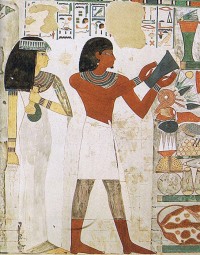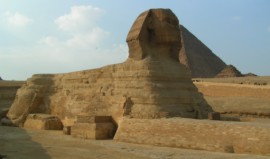Art in Ancient Egypt
2 min read

Ancient Egyptian art works predominantly consist of wall paintings, reliefs, stone carvings, sculptures, statues, statuettes and funerary artifacts found in temples and tombs. They depict scenes from daily life such as work on the fields and writing scribes, special events such as notable battles and religious themes - gods and afterlife and are very precious source for history of ancient Egypt. Ancient Egyptian paintings and sculptures including colors remained very well preserved because of extremely dry climate and provide a valuable insight in daily life, social hierarchy, political organization, religious beliefs and other aspects of life in ancient Egypt.

Ancient Egyptian paintings are characterized by strict rules and principles which remained practically unchanged for thousands of years. Ancient Egyptian artists had a great sense for order and balance although ancient Egyptian artworks appear surreal and unnatural because of strict standards. Figures were depicted with simple lines on flat background without any spatial depth. The head and feet are almost always depicted in profile, while the bodies and eyes look strait ahead. Ancient Egyptian art mostly served for political and religious purposes but it was also used as propaganda by the pharaohs. Besides for strict rules, ancient Egyptian art is also notable for use of symbolism. Different colors represent different meanings, while animals and animal forms symbolize special powers and characteristics of a particular animal. For example, scarab which is linked to Khephri (the god of the rising sun) symbolizes rebirth, while cats symbolize grace and poise.

Ancient Egyptian sculptures almost exclusively consist of gods and pharaohs. They do not represent the true physical characteristics of rulers and gods but their mightiness and power. Like painting, sculpture in ancient Egypt followed strict standards and rules which means that the ancient Egyptian sculptures are stiff, formal and unnatural. Pharaohs were represented in sitting position with hands placed on the knees, scribes in a sitting position with crossed legs and papyrus in hands, and the slaves in kneeling position. Like in painting, size in sculpture represents the social status - the larger the sculpture the higher the social position. Reliefs and stone carvings were also very popular type of statues in ancient Egypt, while the most famous is probably the Great Sphinx at Giza. Sphinx - the sculpture with a human face and body of a lion stands as a guardian over the pyramids of Giza and is the earliest known monumental sculpture dating from the 3rd millennium BC.

Development of hieroglyphic script was followed by creation of literary works which predominantly consist of hymns to the gods and pharaohs, funerary and mythological texts, biographies and works describing notable events, etc. among which is best known the Book of the Death.

Little know about music in ancient Egypt. Art works depict instruments, singers and dancers who performed vocal and instrumental music. Instruments used by ancient Egyptian musicians were sistra, harps, double clarinets, flutes and various drums.